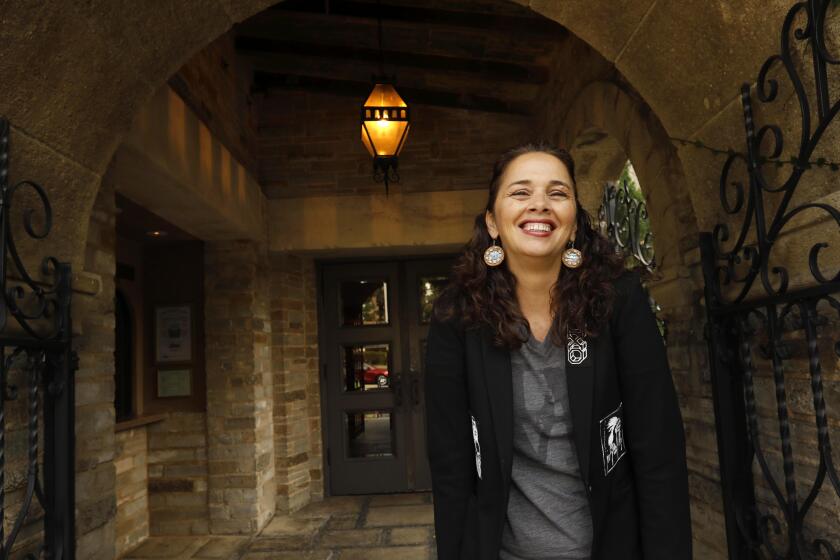Magna Carta coming to L.A.
Americans who were around during the British Invasion of the mid-1960s probably remember how polarized the music-loving public could become over the competing imports.
The Beatles or the Stones? The Kinks or the Dave Clark Five? The Animals or the Zombies?
The same thing is starting to happen when it comes to the Magna Carta, one of democracy’s fundamental documents, which will visit the Los Angeles County Museum of Art from April 26 to May 11. Its showing, to be announced Monday, will be among the events in the annual BritWeek celebration that honors the cultural crosscurrents between Angelenos and Angles (not to mention Saxons, Celts, Normans and subsequent residents of the British Isles).
There will be no extra charge to see the Magna Carta in the museum’s European galleries. LACMA’s other BritWeek event will be the April 30 premiere of “Beyond Time: William Turnbull,” a documentary about the contemporary British artist.
There is some confusion to sort through, however, when it comes to figuring out just which Magna Carta L.A. will be hosting. In 2009, the document spent six months at the Ronald Reagan Presidential Library in Simi Valley and was seen by a reported 169,000 visitors. How special is it if it’s back so soon?
It turns out that the Magna Carta coming to LACMA isn’t the same document at all — not even the same wording.
Agreed to on June 15, 1215, the Magna Carta settled things between King John and the English barony, which had rebelled against his usurpation of their traditional rights. The document — actually a peace treaty — enumerated limits on the king’s power. The one seen at the Reagan Library belongs to Lincoln Cathedral in England and is one of four known copies dating from 1215. Two others reside at the British Library in London and one at Salisbury Cathedral, whose website brags that it is “the best preserved … original.”
The one coming to LACMA is a revised Magna Carta written in 1217. King John, it turns out, reneged on his pact and went on trying to lord it over the barons until his death in 1216. That put John’s 9-year-old son, Henry III, on the throne, and by 1217, the youngster’s regent had issued a second and a third edition of the Magna Carta for complex political reasons.
The LACMA Carta comes from the Bodleian Library at Oxford University. Like all 17 of the 13th century Magna Cartas known to exist, it lacks the decorative touches that visitors to the Getty’s medieval manuscript exhibitions are accustomed to seeing. This is no show pony but a political and legal workhorse. When, after nearly 800 years, the Bodleian put all four of its Magna Cartas on display together for the first time in 2007 (for exactly six hours), an unimpressed writer for the Guardian described them as “four grubby sheets of parchment with a few battered wax seals.”
Nevertheless, when a 1297 edition of the Magna Carta was auctioned in 2007, seller Ross Perot, who had bought it for $1.5 million in the 1980s, reaped a nice profit for his foundation when investment executive David Rubenstein sprang for it, paying $21.3 million.
The Oxford Magna Carta is a bit of a latecomer to touring. Its first public display in the United States happened by accident last spring. Sent to New York for a special event for Oxford alumni, it got stranded there because an Icelandic volcano had turned European skies unfriendly for flying. An impromptu 51/2-week showing was arranged at the Morgan Library & Museum.
A New York Times critic who reviewed the exhibition dwelled more on Magna Carta’s historic significance than its physical attributes, which he wrote were “humble,” with “Latin text … crowded into a tight space, with almost no margins, though elegantly laid out…. It is far less grand in size than the foundational documents of the United States; it can almost be missed, encased atop a pedestal in front of a fireplace.…”
The Lincoln Cathedral Magna Carta, by contrast, is a veritable road dog. It first arrived on these shores in 1939, at the New York World’s Fair. It returned in 1987, visiting the 13 original Colonies and six Midwestern states as part of the celebration of the 200th anniversary of its great-great-great-great grandnephew, the U.S. Constitution. It swung back in 2007 for the 400th anniversary of Jamestown, the first permanent English colony in the New World — although its 81-day run at the Contemporary Art Center of Virginia in Virginia Beach was deemed an expensive flop by the local press, costing the city $1.1 million and drawing fewer than a third of the expected 70,000 viewers.
Since then, Lincoln’s Magna Carta also has been seen in Philadelphia, New York and at the Reagan Library.
More to Read
The biggest entertainment stories
Get our big stories about Hollywood, film, television, music, arts, culture and more right in your inbox as soon as they publish.
You may occasionally receive promotional content from the Los Angeles Times.






